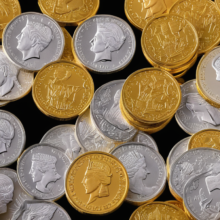Should I Buy Gold and Silver? – Unveiling the Value in Precious Metals
Navigating the world of investments can often feel like a labyrinth, with countless options and strategies to consider. One question that frequently surfaces is, ‘Should I buy gold and silver?’
These precious metals have long been regarded as a safe haven in turbulent economic times, a beacon of stability amidst market chaos. But does this traditional perspective hold true in our modern financial landscape?
Delving into the intricacies of investing in gold and silver, we’ll explore their historical performance, the factors influencing their market value, and the pros and cons of incorporating them into your investment portfolio.
Join us as we unravel the mysteries of gold and silver investments, providing you with the knowledge you need to make informed financial decisions. This is your guide to understanding the true value of these precious metals in the investment world.
“Should I buy gold and silver?”
The question of whether to invest in gold and silver is a common one among potential investors. The answer largely depends on your investment goals and risk tolerance. Gold and silver, like any investment, come with their own set of risks and rewards.
One of the main reasons people invest in gold and silver is to hedge against inflation. As the cost of living increases, the value of gold and silver generally follows suit. This makes them a popular choice for those looking to protect their wealth over the long term.
Another factor to consider is the role of gold and silver in a diversified portfolio. They can provide a counterbalance to other more volatile investments, potentially reducing overall risk.
However, there are drawbacks to consider. For one, gold and silver do not generate income like stocks or bonds. They also come with storage and insurance costs, which can eat into potential returns.
The decision to invest in gold and silver ultimately comes down to your individual circumstances. Consider your financial goals, risk tolerance, and the current economic climate before making a decision.
- Gold and silver can act as a hedge against inflation
- They can provide balance in a diversified portfolio
- Consider potential drawbacks such as lack of income and storage costs
While it’s important to do your own research, speaking with a financial advisor can provide valuable insights and help guide your decision. Remember, every investment comes with risk, and it’s essential to make informed decisions.
Whether you choose to invest in gold and silver or not, understanding the benefits and drawbacks of these precious metals can help you make a more informed investment decision.
What is the price of gold and silver?
The price of gold and silver is a topic of interest to many potential investors. The value of these precious metals is influenced by a variety of factors, including global economic conditions, supply and demand, and investor behavior.
Gold, often seen as a safe haven asset, tends to increase in price during times of economic uncertainty. The price of gold is typically quoted per ounce, and can be tracked through various financial news sources or investment platforms.
Similarly, the price of silver is also subject to market fluctuations. Although it is less valuable than gold, silver has industrial uses that can influence its price.
Investors often consider buying gold and silver as a way to diversify their portfolio. However, it’s crucial to understand that the prices of these metals can be volatile. Therefore, it’s important to do thorough research and consider all factors before making an investment decision.
Here are some key points to consider when evaluating the price of gold and silver:
- Global economic conditions: In times of economic uncertainty, the price of gold and silver can increase as investors seek safe haven assets.
- Supply and demand: Limited supply and high demand can drive up the price of these metals.
- Investor behavior: Investor sentiment can also influence the price of gold and silver. If investors are bullish, prices can rise. Conversely, if investors are bearish, prices can fall.
Remember, investing in gold and silver is not without risks. It’s important to weigh these risks against potential rewards and to consider your own risk tolerance and investment goals.
How to buy gold and silver safely?
When contemplating the question, “Should I buy gold and silver?“, it’s essential to consider the safety aspects. The first step towards a secure purchase is choosing a reputable dealer. Look for dealers who are members of professional trade bodies, as they are required to uphold stringent ethical standards.
The next step is to understand the pricing. The prices of gold and silver are based on their weight, usually per troy ounce. Be aware that dealers may also charge a premium over the spot price.
It’s also crucial to consider the form of your investment. Gold and silver are available in various forms, such as coins, bars, and even jewelry. Each has its pros and cons, and your choice should align with your investment goals.
- Coins: They are easy to handle, store, and trade. However, they may carry a higher premium due to their collectability.
- Bars: They offer more metal for your money but can be challenging to store and trade.
- Jewelry: It serves a dual purpose as an adornment and investment. However, its value may not strictly follow metal prices due to craftsmanship and design.
Another critical factor is storage. If you’re buying physical gold and silver, you’ll need a safe place to store them. Some people choose to use home safes, while others prefer bank deposit boxes or professional vault services.
Lastly, make sure to keep all your purchase receipts. These will be vital for insurance purposes and if you decide to sell your gold and silver in the future.
Remember, buying gold and silver should be a strategic decision, made after careful consideration and research.
Is investing in gold and silver profitable?
The question “Should I buy gold and silver?” is often asked by individuals seeking to diversify their investment portfolio. Gold and silver have been recognized as valuable commodities for thousands of years. Their demand is driven by their practical use and their role as investments.
Investing in gold and silver can be profitable, especially during economic downturns. When the stock market is volatile, investors often turn to gold and silver as safe havens. This increases their demand and consequently, their price. Gold and silver also act as a hedge against inflation, helping to preserve wealth over the long term.
However, like all investments, buying gold and silver comes with risks. The prices of these precious metals can be volatile, influenced by factors such as geopolitical events, market speculation, and supply and demand imbalances. Therefore, it’s crucial to understand these factors before investing.
Here are a few considerations when investing in gold and silver:
• Market Timing: Buying at the right time can be tricky. Prices can fluctuate rapidly, and it’s impossible to predict with certainty when they will rise or fall.
• Storage Costs: Physical gold and silver need to be stored securely, which can incur costs.
• Liquidity: While gold and silver are generally considered liquid assets, selling them quickly for a good price may not always be easy.
Ultimately, whether investing in gold and silver is profitable will depend on various factors, including the investor’s financial goals, risk tolerance, and market knowledge.
What are the risks of buying gold and silver?
Gold and silver, while often considered safe-haven assets, come with their own set of risks. One of the primary risks is the volatility of the market. Precious metals, like all commodities, are subject to price fluctuations that can be unpredictable. Gold and silver prices can be affected by a variety of factors including economic conditions, geopolitical tensions, and changes in supply and demand.
Another risk is the cost of storage. Unlike stocks or bonds, physical gold and silver need to be stored in a secure location. This can lead to additional costs, including insurance and security measures.
Investing in gold or silver also lacks liquidity. While these precious metals can be sold relatively easily, the process may take time and often involves fees or commissions. This can make it difficult to access your investment in a pinch.
In terms of investment diversification, while gold and silver can be a part of a diversified portfolio, over-reliance on these metals can lead to lack of diversification. This is because the performance of gold and silver tends to be negatively correlated with stocks and bonds.
Lastly, there’s the risk of fraud. Unfortunately, there are unscrupulous dealers in the precious metals market who may sell counterfeit or low-quality products. Therefore, it’s crucial to buy from reputable dealers to mitigate this risk.
While these risks should be considered, it’s also important to note that gold and silver can serve as a hedge against inflation and currency fluctuations. However, like any investment, it’s crucial to do your research and understand the risks before diving in.
How to store gold and silver securely?
Storing your gold and silver securely is a crucial step after purchasing these precious metals. It’s not enough to simply buy gold and silver; you need to ensure their safety as well. You can opt for home storage, which offers quick access to your assets. However, it comes with risks like theft or damage. If you choose this route, invest in a high-quality safe and consider hiding it in a discreet location.
Alternatively, you can store your gold and silver in a bank deposit box. While this option provides high security, it might not be as accessible as home storage. Some investors also worry about the possibility of bank seizures.
Another option is professional storage facilities. These are often highly secure and insured, providing peace of mind. They can offer allocated or unallocated storage. Allocated storage means your gold and silver are kept separately from other assets, while unallocated storage involves your assets being mixed with others.
Lastly, some people choose to store their gold and silver overseas. This can provide additional security and diversification, but it also comes with its own set of challenges, such as understanding foreign regulations and dealing with potential language barriers.
Remember, the key is to balance accessibility with security when deciding how to store your gold and silver.
Are there taxes on gold and silver purchases?
When considering the question, “Should I buy gold and silver?” it’s crucial to understand the tax implications that come with these purchases. In many jurisdictions, gold and silver are considered tangible personal property, which means they are subject to sales tax. However, the specifics can vary greatly depending on the location and the type of precious metals being purchased.
- In some U.S. states, there are exemptions for bullion or coins made of precious metals. These exemptions typically apply when the value of the metal, rather than the form it takes, determines the item’s worth.
In contrast, some countries in the European Union apply a Value Added Tax (VAT) to silver purchases but not to gold. This is because gold is often viewed as a form of currency, while silver is treated more like a commodity.
When buying gold and silver as an investment, it’s also important to consider potential capital gains tax. This tax is levied on the profit made from selling an asset, such as gold or silver, that has increased in value.
Remember, tax laws are complex and can change, so it’s always a good idea to consult with a tax professional or financial advisor when considering a significant investment in gold and silver. This will ensure you’re fully informed about any potential tax liabilities and can make an educated decision.
What affects the price of gold and silver?
Several factors influence the price of gold and silver. Market demand and supply play a significant role. When demand exceeds supply, prices tend to rise, and when supply surpasses demand, prices usually drop.
Economic indicators such as inflation, currency values, interest rates, and stock market performance also affect prices. For instance, in periods of economic uncertainty or inflation, investors often turn to gold and silver as safe-haven assets, pushing their prices up.
Geopolitical events can create uncertainty, leading investors to seek refuge in precious metals. For instance, wars, political unrest, or changes in government policies can increase demand for gold and silver, thus affecting their prices.
Mining costs, including labor, energy, and equipment, can also influence prices. If these costs rise, it could lead to a decrease in supply, pushing prices up.
Finally, central bank reserves can impact prices. When central banks, which hold significant amounts of gold, decide to sell off their reserves, it can lead to an oversupply in the market, causing prices to drop.
Understanding these factors can help investors make informed decisions when contemplating whether they should buy gold and silver. It is crucial to keep an eye on these elements and how they interact to influence the prices of these precious metals.
Conclusion: Should I Buy Gold and Silver?
In summary, the decision to invest in gold and silver is a personal one that depends on various factors. The current price of these precious metals is a crucial consideration, as is understanding how to purchase them safely to avoid fraudulent transactions.
Investing in gold and silver can be profitable, especially during economic downturns when their value typically rises. However, risks are inherent in any investment. For gold and silver, these may include market volatility and the potential for theft if adequate security measures aren’t in place for storage.
Taxes on gold and silver purchases are another factor to consider, as they can impact overall returns. Various elements can affect the price of gold and silver, including supply and demand, geopolitical events, and economic indicators.
Looking forward, various trends could impact the value of gold and silver, such as technological advancements in mining and changes in monetary policies. Therefore, staying informed and understanding the market is essential.
Before making any investment decision, it’s crucial to do your research and consider seeking advice from a financial advisor. Investing in gold and silver can be a strategic move, but like any investment, it should align with your overall financial goals and risk tolerance.




